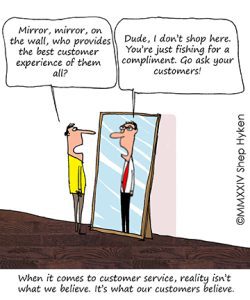 The difference between perception and reality is an important topic that every CEO, business owner, leader, manager, and supervisor must understand. When it comes to customer service and customer experience (CX), there is a difference between perception and reality.
The difference between perception and reality is an important topic that every CEO, business owner, leader, manager, and supervisor must understand. When it comes to customer service and customer experience (CX), there is a difference between perception and reality.
Shep Hyken explains the difference in this article. We encourage you to read it closely.
First, how we think our customers perceive our customer service and CX is often not the reality. It’s just our perception. Reality isn’t what we think or believe. It’s what our customers say. Often, there is a big difference between our perception and the reality of our customers’ experiences.
Some may be saying, “Shep, you’ve covered this before.” Yes, however, it is worth covering again, especially since Shep Hyken’s friend Stephen Van Belleghem released his excellent book, A Diamond In the Rough, where he quotes a Bain survey finding that “80% of CEOs think their company is customer-centric, but only 8% of customers agree.”
One of Shep Hyken’s LinkedIn followers, Rajat Chawla, read Shep Hyken’s Forbes article about Van Belleghem’s book and asked, “What’s your best advice to bridge the gap?” As I always promise, if you reach out to me on any social channel and ask a question, I’ll answer it there or in Shep Hyken’s newsletter, in Shep Hyken’s videos, in Shep Hyken’s podcast, or on Shep Hyken’s TV show, Be Amazing or Go Home. So, here’s Shep Hyken’s answer:
There are at least three strategies for narrowing the gap between these perceptions:
- Leaders need to pay attention to their data. After they do a self-assessment, which is their perception, they should – if they haven’t already – survey their customers to discover their reality. That’s the most accurate way to measure the difference.
- Leaders should “mystery shop” their companies themselves. They should learn firsthand what it’s like to be a customer. They should be looking for the experiences their customers receive during peak hours or in the middle of the night, what a sales call is like compared to a customer service call, and more.
- Finally, leaders should spend time on the front line, either shadowing (listening in) on customer support calls or taking the calls themselves. I addressed spending time on the front line in Shep Hyken’s first book, Moments of Magic when I covered the All Aboard program in which executives spent one day each quarter with a salesperson visiting customers. In Shep Hyken’s most recent book, I’ll Be Back, I wrote about how Bill Gates visited the customer support center and asked to take customer support calls. The power of spending time on the front line is undisputed! Experiencing firsthand comments from customers is a powerful dose of reality – hopefully, good reality!
What I love about these three strategies is that other than a little time and effort, there is little or no expense to implement them. So, what are you waiting for? If you haven’t already done so, discover the difference between your perceptions and your customers’ reality. And Shep Hyken’s wish for you is that there is little or no difference between the two!
James P. Randisi, President of Randisi & Associates, Inc., has been helping employers protect their clients, workforce and reputation through implementation of employment screening and drug testing programs since 1999. This post does not constitute legal advice. Randisi & Associates, Inc. is not a law firm. Always contact competent employment legal counsel. To learn more about the rights of employees who test positive for marijuana, Mr. Randisi can be contacted by phone at 410.336.0287 or Email: info@randisiandassociates.com or the website at randisiandassociates.com


